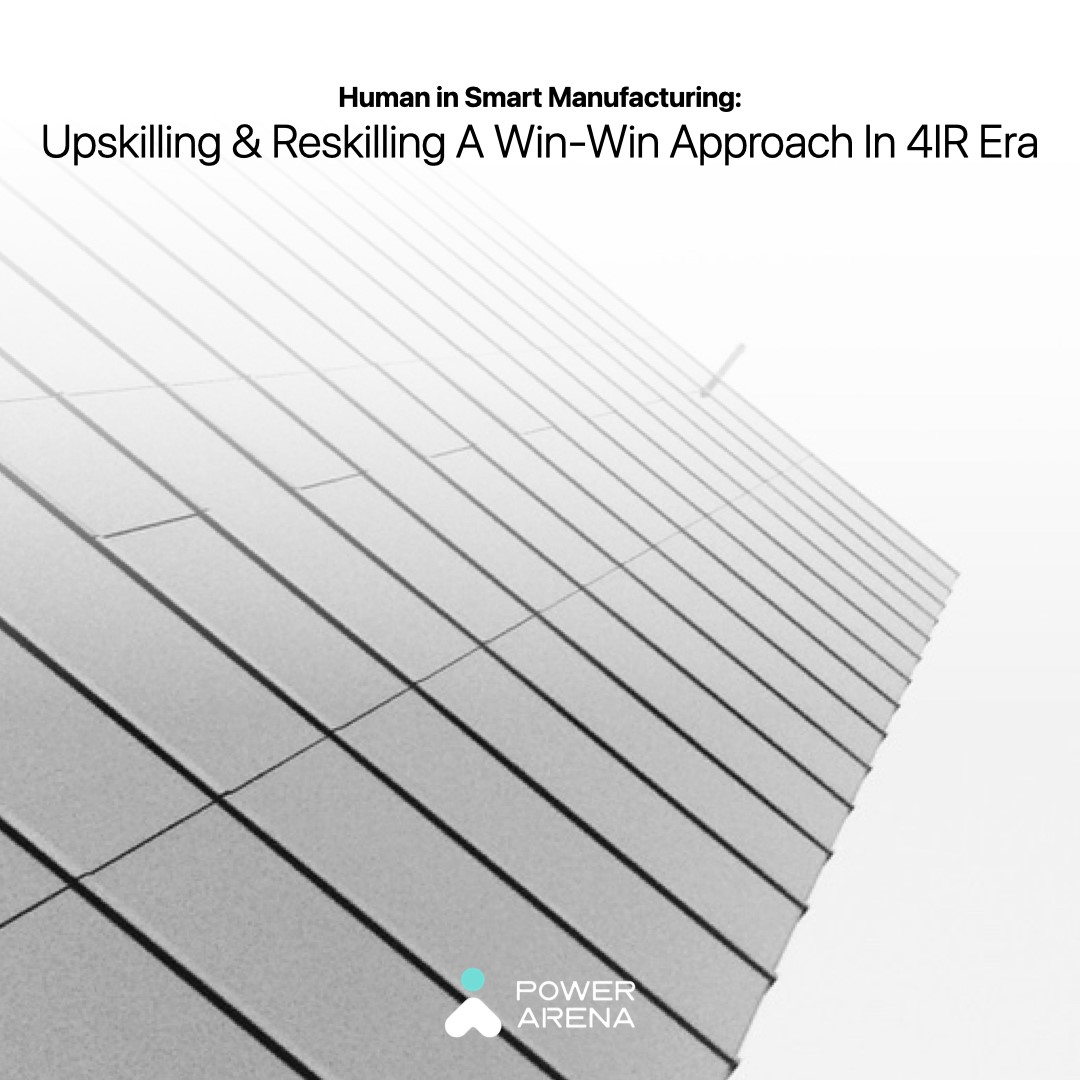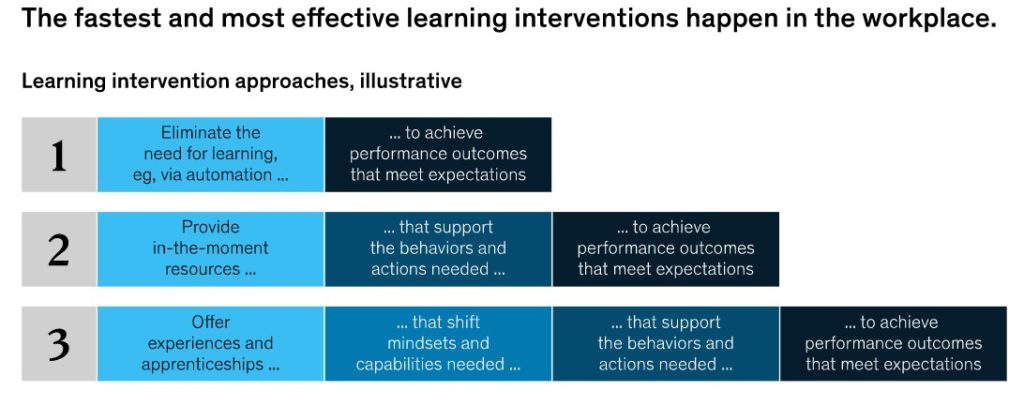Human in Smart Manufacturing: Upskilling and Reskilling A win-win approach in 4IR era

In volatile times, people need the ability to adapt to the environment rapidly. In past years, COVID forced manufacturers to master the challenges of digital transformation, meanwhile, generating a big wave of “reskilling” and “upskilling.” Now, being agile is no longer staying at the company level, but narrowed down to individuals. As we have emphasized in the past few weeks, smart manufacturing is people-oriented, and the fundamental way is to continuously learn new knowledge and adapt to the changing environment. This week, we’ll take you through why it’s important to upskill people in the era of Industry 4.0, and how the Global Lighthouse Factory puts this concept into practice.
Workforce development is a win-win
When thinking of improving skills, everyone must have a few specific terms that come to mind. For example, “on-job training.” Including holding learning sessions during working hours, or sending employees back to school. Most of us believe that the employees get the most benefits, but in fact, not only the employees who are trained get the benefit but also the employers, too.
Not simply crossing out the to-do list
Investing in your employees is investing in fundamental business needs. Companies that wish and give the opportunity to let employees grow, tend to find more success in turnover rate. Employees who feel neglected or taken for granted will probably find their dream job elsewhere. Although surviving in the job market is never easy, skilled talents will still do so to find a job that suits — and most importantly, appreciates them.
Let it be meaningful
Dharmesh Shah, founder and CTO of HubSpot, suggested that employers should make it easy for employees to question, challenge, also share their opinions. When an idea doesn’t have merit, make them take the time to explain why.
“You may not always implement every idea, but you can always make employees feel valued for their ideas.”
Stand out among competitors by creating room for creative, innovative ideas and helping our employees have the courage needed to make changes in the future.
Smarter, not harder
Workforce development help increases working productivity, further preventing your employees from burning out. Unnecessary stress from work can significantly impact your employees’ focus and productivity.
Build your dream team
By investing in uptraining and retraining, your company benefits from a highly skilled team, and your employees can feel confident about what they are doing.
Concerns from employees
Workers, particularly Millennials, prioritize development opportunities when looking for a job. A 2016 Gallup survey found that 87% of millennials rate “career growth” and “development opportunities” as important in a job.
How does technology assist workforce development?
Digital transformation requires people to master and understand new technologies. Successful workforce development is built on a clear understanding of which skills are needed for specific workers in order to meet their mutual goals. More specifically, finding the most effective ways to help employees perform better in their roles.

The fastest and most effective learning interventions happen in the work place. (source)
This aims to make it as easy as possible for people to do the right thing in any working environment. Approaching from a performance perspective, today’s most common methods, such as classroom training or online learning are no longer the default choice. Instead, organizations emphasize human-machine collaboration that helps people during the execution of their work. For example, implanting AI vision in a production line will be a great example that helps employees who work in the factory with the following benefits.
Eliminate the need of “learning”
Can a task be automated, or designed to be as intuitive and error-proof as possible? AI vision deployed on the production line can share the most complicated work of IE engineers, which is to calculate single cycle time. The start-to-start technology calculates more accurately than a stopwatch. The team no longer needs to undertake annoying routines, and use the time saved for further studies and training to practice higher work values.
Provide solutions at the key moments
The best time to learn something well is right when you encounter difficulties. That might be the first time you use a new approach, the first time operating digital tools, first time to solve a bottleneck. Thanks to AI technology, you may intuitively restore the scenario of any time point you wish to review, it also provides a real-time image of the production line. With this, companies can ensure that during these critical moments, solutions are just one click away, efficiently helping employees learn.
Empower by technology
In some situations, some tasks are too complex, too different, or too risky to learn on the job. As a result, we can build a simulated situation using technology. For example, in remote planting, we do not risk our budget to built a new factory in a foreign country and later found out it contains loads of operating difficulties. In this case, we build a model with digital twins, trying new approach and methods in a safer and more efficient environment to come up with feasible solutions.
Generally speaking, getting familiar with AI vision solutions is a suitable workforce development for factory employees. AI vision record working time around the clock, capture operator performance, and provide SOP optimization data to visualize the production line. Real-time image can also make remote assistance no longer a difficult task. All-round help the team get closer to digital transformation and achieve higher work value.
Learn how to transform your factory into high yield, high quality output powerhouse at <Beyond productivity: Transform Your Smart Factory into High Yield Powerhouse.>
Let global lighthouse factories give us a demo
Lighthouse Factory places a high value on workforce development because they know that agile ability can maximize the benefit of digital transformation. They also value humans as the core of 4IR, and focus on the growth of individual capabilities. They give members at all levels of the company the opportunity to participate in building innovative, creative decisions. Successful transformation requires the efforts of the entire team, and “humans” are a necessary element for building a team. As for the outstanding example, WEF and Mckinsey mention Simens and hp in their white paper for 2021.
Siemens: Siemens matches individual job profiles to a 4IR skill roadmap that lays out a tailored upskilling path for eachThe upskilling path is laid out according to the job profile, taking into consideration the key technologies and level of competence required.
HP Inc: Shifting tasks to upskill the workforce.
An investment that will never go wrong
By investing in training and technology to upskill employees, companies can enjoy a happier working atmosphere, lower employee turnover, and overall growth opportunities—not to mention increased revenue. In the wave of transformation, if we want to achieve smart manufacturing, we still need to prioritize “human” and make long-term planning and investments. Next week’s blog will be the last chapter of “Human in smart manufacturing.” We will share our thought on why people are still the factory heroes of manufacturing.
Read More:
Human in Smart Manufacturing: Data Driven Decision Making
Human in Smart Manufacturing: Thriving in the Era of Smart Tech
Source:https://www3.weforum.org/docs/WEF_GLN_2021_Reimagining_Operations_for_Growth.pdf/https://www.mckinsey.com/capabilities/operations/our-insights/operations-blog/supply-chain-network-reconfiguration-for-resilience/https://www.gallup.com/workplace/236438/millennials-jobs-development-opportunities.aspx/https://www.tinypulse.com/blog/employee-development-win-win/https://www.linkedin.com/pulse/20130523165741-658789-beyond-the-paycheck-what-we-wish-for/
